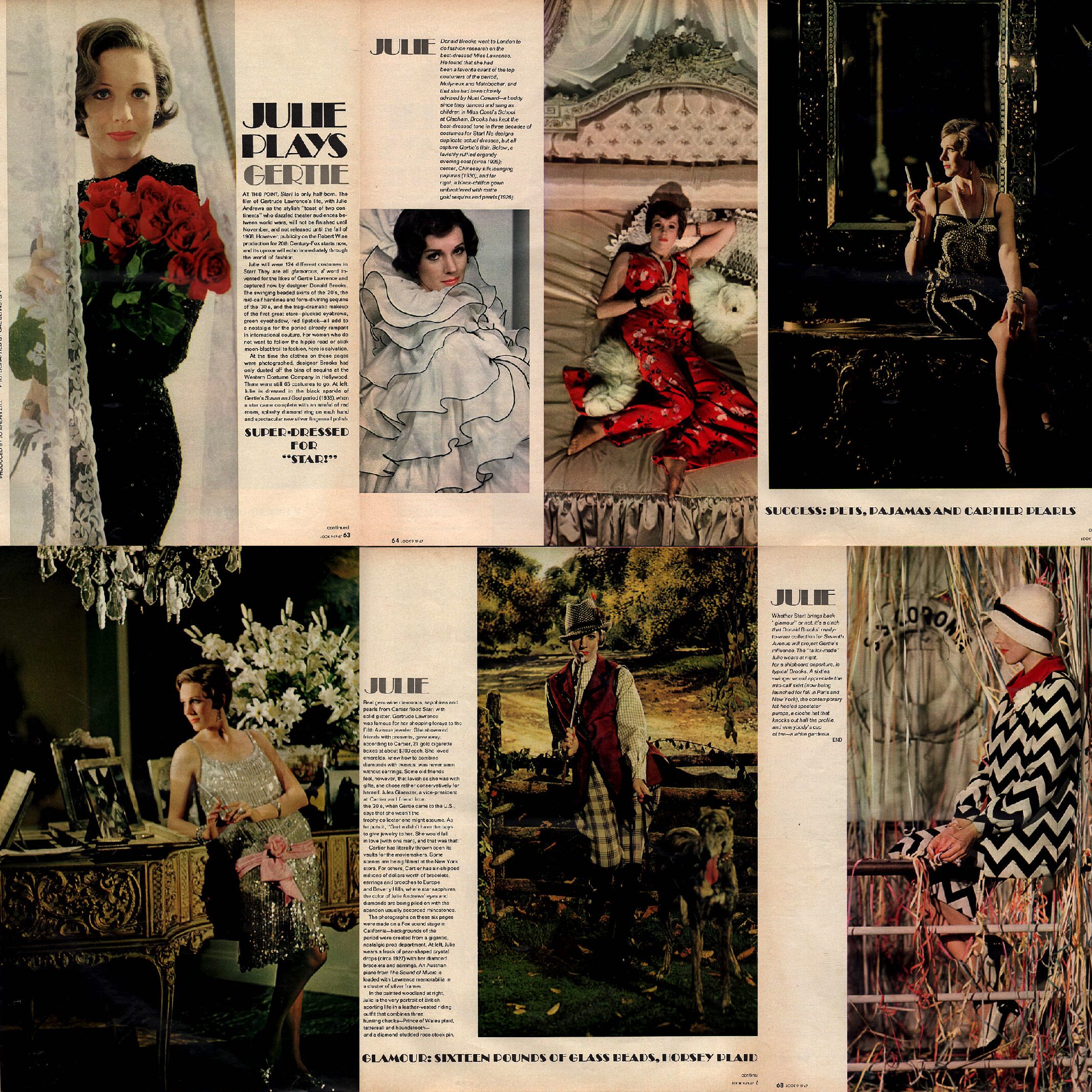
THE GLAMOR OF GERTIE
Star! was one of the last big studio musicals, an expensive genre that was rapidly going out of style, as “the Sixties” swept through Hollywood. Riding the wave of Counterculture and new technologies that made production cheaper, a new generation of filmmakers were freed from the tyranny of the soundstage.
The second collaboration between Julie Andrews and Robert Wise, after the huge success of The Sound of Music, Star! portrayed the glamor and opulence of Gertrude Lawrence’s life and career. The title was inspired by the “star quality” that Lawrence’s close friend and collaborator Noel Coward attributed to the actress and that made “Gertie” a screen and stage as well as a society darling of the era. In her own biography, A Star Danced, Lawrence recollects her path to stardom as foretold by a fortune telling machine:
On the pier, among other penny-in-the-slot machines was one showing a gaudily painted picture of a gypsy. The machine promised to tell your fortune for a penny. I dropped my copper piece into the slot and waited anxiously while the machine ground out a few bars of a popular tune; it then proceeded to stick a tongue of pink cardboard at me. There were words printed on it. I tore off the slip and read my penny destiny:
A star danced,
And you were born.
I accepted my fate without hesitation. The gypsy meant to tell me that I would be a dancer and someday I would be a star.
Coward wrote Private Lives with Lawrence in mind. The production, in which she acted opposite the playwright, opened at the Phoenix Theatre, London, in September 1930, setting the tone that would characterize comedies of manners for a decade or more: sophistication, brittle wit, and chicness. Lawrence’s greatest triumph was perhaps as Liza Elliot in the Moss Hart–Kurt Weill musical Lady in the Dark (1941). Throughout her career, her singing and dancing complemented her uniquely compelling stage presence; she remained for a quarter-century one of the most popular stars on the American and British stages largely due to it. She spent the years following her 1940 marriage to Richard Aldrich, an American producer, in the United States. In March 1951 she opened in Rodgers and Hammerstein’s The King and I on Broadway, during the run of which she died.
Conceived to reflect the era and Lawrence’s lavish style, Star! broke a record with the number of outfit changes that Julie Andrews had to execute. Alongside Andrews as Lawrence, Daniel Massey starred as Noel Coward, who was his real-life godfather.
The film premiered in 1968 at the Dominion Theatre, replacing The Sound of Music, which had run there for the previous three years. The Duke and Duchess of Kent attended the screening, which was promoted as a roadshow theatrical release and included a film program similar to a playbill. Ms. Andrews has generously supplied us with her copy of the program and an edition of Look, the magazine that promoted the film with a piece on her prior to the premiere. The below are rare scans from these publications:
Her biography in the program reads:
When Julie Andrews stepped up before the assembled array of filmdom’s glittering personalities to accept the Oscar for her performance in “Mary Poppins,” and then followed this achievement with a smashing personal triumph in Robert Wise’s “The Sound of Music,” Hollywood and the world press commented on her amazing and meteoric rise to fame in such a brief span of years. Nothing could be further from the truth! By the time Miss Andrews was recognized by her peers and by millions of fans all over the world, she was well-prepared for stardom by twenty years of hard work, study and professional experience. Julie was born in a little town called Walton-on-Thames, about twenty miles from London. Her parents were divorced when she was very young and her mother remarried an entertainer, Ted Andrews, whose name Julie adopted. Andrews was a musician and a singer and Julie’s mother was an accomplished pianist; together they worked up an act for vaudeville. Traveling around the music halls of the British provinces gave Julie her first taste of show business.
At the age of 12 she astounded the audience at the London Hippodrome in the “Starlight Roof” Revue with an operatic solo in a clear and crystal voice which assured her a future in the theatre. By 1952 she was one of the most successful and highly paid actresses in England, and Vida Hope sought her out to play the lead in “The Boy Friend,” the London hit which she was planning to send to Broadway. Julie accepted with considerable reluctance, not relishing a long contractual exile in an alien land.
But New York hailed the young star in the musical spoof and took her to its collective heart and kept the show running for a year. She had proved herself adept in the frothy, campy, musical pastiche, but the big trial still lay ahead. It came when Alan Jay Lerner called her to audition for the difficult role of Eliza Doolittle in “My Fair Lady.” the musical version of Shaw’s “Pygmalion.” It was a most demanding role, requiring real acting ability, an impish cockney humor, and a graceful elegance all wrapped up in a musical score that embraced more than a half dozen difficult numbers. Results: “My Fair Lady” made Broadway history and Julie Andrews’ stardom was assured.
After a 2 year run on Broadway, Miss Andrews returned to London to play the role for eighteen months and then came back to Broadway to roll up 873 performances in “Camelot.”
Walt Disney then stepped into the picture and offered her the starring role with Dick Van Dyke in “Mary Poppins” which won her an Academy Award. ”The Americanization of Emily’ followed. Robert Wise then tapped her for “The Sound of Music” which was to become the greatest smash in the entire history of the screen. Since then she was co-starred with Max Von Sydow in “Hawaii,” “Torn Curtain” with Paul Newman and “Thoroughly Modern Millie.” She is probably the only star who never made a film which did not make a profit.
As one journalist put it, “The lady is more than a great star, she is a whole whirling dazzling constellation. Julie is not just an ordinary movie personality, she is a phenomenon.”
